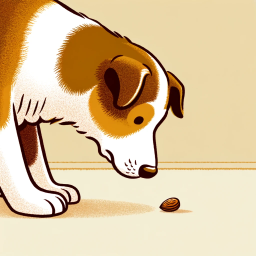Can Dogs Eat Vinegar Chips (and Salt): What You Should Know

Have you been in situations wherein you’re feeding on a delicious bag of chips, and your dog comes in looking you in the eyes undeterredly so that you could toss a few at him to eat?
You’d admit that you’ve been tempted one time or the other to give in to his need but taken aback due to the uncertainty of the chips’ aptness for your dog. You are not alone!
Many dog owners have asked the question, “can dog eat vinegar chips?” to be sure if they aren’t toxic or harming to their dog. For this reason, we’ve, in this article, broken down the reasons why chips fried with vinegar may be bad or good for your dog.
Can Dogs Eat Vinegar Chips?
To begin with, note that giving some dogs potato chips fried with salt and vinegar once in a while won’t pose any real problem. It is mostly when you give it to them without moderation that a problem may arise.
Be that as it may, potato chips, plantain chips, or any chips prepared with salt and vinegar won’t do your dog any good, neither is it healthful for you as the owner of the dog. But unlike dogs, the human body is more adaptive to diets high in fat and sodium— although with cautious moderation.
Given this, salty foods are not ideal for dog consumption as they can cause your dog to become intensely tasty time and time again. He will feel a pressing urge to urinate as well; this is usually because the kidney has been overworked due to too much sodium.
Even worse, it can develop into something more serious such as sodium ion poisoning. When this arises, some of the symptoms you’ll notice in your dog are high temperature, seizures, nausea, vomiting, including diarrhea to the point of dehydration. Sodium-ion poison can cause your dog great discomfort and can eventually lead to death.
A dog who is nursing a heart problem is more susceptible to the damages that can be caused by salt and vinegar, so should never think of letting him have a bite of the chips or picking one that dropped on the floor.
To help understand how bad salt is for dogs, research from the National Research Council of the National Academies [1] reveals that an adult dog( one weighing around 24 to 55 pounds) has a standard daily allowance of 200mg of salt in his body.
A bag of chips usually carry around 170mg of salt, so when your dog consumes an amount a little bit close, he may be exposed to a lot of health risks, some of which can eventually lead to death.
Is giving your dog chips beginning to seem like an entirely bad idea already? Don’t fret. The above can only happen if you feed your dog with too many chips or if he serendipitously stumble upon a bag of chips lying carelessly in house and devours it completely.
Eventually, if you deem it virtually impossible to deprive your dog of some chips, you can settle for brands that include very low amount of sodium and calories. Although they may taste less delicious, you will be saving your dogs from some health risks, and you’ll be helping your self too healthfully. However, this doesn’t mean moderation should be neglected.
Furthermore, different dogs react differently to salt and vinegar; this makes it difficult to specifically tell if chips made with these concentrations are bad for your dog.
How Do I Know If Vinegar Chips is bad for My Dog?

Keep in mind that some dogs will eat chips made with vinegar and won’t react negatively; for others, it may be a terrible experience. So, how do you know if vinegar crisps is okay for your dog?
Here’s a trick I usually employ:
Add some little drops of vinegar to your dog’s regular food and give him to eat. After consumption, if he reacts negatively with vomiting or by becoming gaseous and eventually weak, then it’s probably very bad for him, and you should avoid giving him again in the future.
Otherwise, if nothing negative happens, then your dog can probably stomach vinegar crisps, and giving him little bits won’t be a bad idea after all.
Read Also: Best Dog Beds for Hairy dogs that Shed
Difference Between White Vinegar and Apple Cider Vinegar: Which Is Ideal for a Dog?


Two common types of vinegar are white vinegar and apple cider vinegar. Either of them can be added to any kind of chips, but they are different and have varying benefits.
White vinegar, also known as spirit vinegar, has a clear, transparent color. It is formulated from the fermentation of grain alcohol, and it usually contains between 4–7 percent acid and between 93-96 percent water.
White vinegar is characterized by a great sour taste and can be used to clean and wash germs off because it has antibacterial properties.
On the other hand, apple cider vinegar has a brown color and is murky. To make apple cider vinegar, apples are mashed and the juice extracted from them; the juice then goes through a fermentation process.
Interestingly, apple cider vinegar can be used to improve heart health, manage dandruff, lose weight, among others. Comparatively, the apple cider vinegar has a lot more nutritional value than its white counterpart; this is because it is made from fruits that carry a lot of health benefits.
Which vinegar is better for my dog?
Undoubtedly, the apple cider vinegar is what you should look out for in the potato chips you buy, given its numerous benefits. However, these benefits will only manifest in humans and not your dog who you only give bits.
Many brands will not boldly write the type of vinegar used, but information about it can be found on the small space at the back where ingredients are written. Regardless, both contain acid, hence moderation should be maintained for your dog.
If a Dog Eats Vinegar Chips with no Problem, What’s the Best Way to Continue?
Certainly, if you give your dog a couple of chips for a day or two each, you might get carried away and lose count of how many you’ve given him or how many you should. While giving bits and crumbs won’t pose any real threats, it won’t be healthful to him over time.
Here’s a method I use to regulate how I give my dog vinegar and salt chips:
1. Let Him Learn a Pattern
Let your dog learn and follow a pattern whenever you have a bag of chips in front of you. The rule should be one chip or a couple at each snack time.
While he will crave for more after one or two, know you’re doing it for his good and never be cajoled into giving in to his demands. Those beautiful eyes shouldn’t break through the wall of your heart; stick to the rule!
If you’re strict about this pattern and don’t veer off the road, your dog will have no choice but to get used to it over time. A dog’s brain can be trained to master certain things just as you can train a child to jettison certain behaviors. Everything shouldn’t be about food and entertainment for your dog.
Read Also: Can Dogs Eat Almonds? Understanding the Risks
2. Pay Close Attention
If a dog has gotten used to eating a couple of chips at each snack time, one shouldn’t throw caution into the wind. The thing is, his reactions may change along the line; that is, he may begin to show symptoms of vomiting, nausea, excessive urinating.
When you notice this, it’s a sign that vinegar chips isn’t going well with him anymore. When this is the case, I suggest you stop giving him for the time being— probably a couple of weeks or up to a month.
As expected, your dog can’t know if vinegar crisps is what’s giving him troubles, so it won’t deter him for begging for more. It is your responsibility as a pack leader to set the boundaries no matter how much he craves.
After about a month of stopping, you can start all over again with one chips at each snack time. Repeat this pattern and your dog will get acquainted with it.
Alternatives for a Dog Who Reacts Negatively
If having tested if vinegar is apt for your dog, you notice negative reactions, and there are close subtitles of human yummies that you can entice him with while enjoying your vinegar chips. You can try popcorn that is devoid of butter or plain chips (one that isn’t made with vinegar and salt).
While eating your regular salt and vinegar chips, you can keep the above alternatives by your side and toss them at him whenever he begs for the vinegar chips. Note, don’t give him without his asking, only do so when you’re eating your vinegar chips, and he asks for it.
But better still, you can avoid eating salt and vinegar chips as they aren’t good for your health. If you must do, streamline it and do so with moderation.
Read Also: Why Is My Dog Shaking When He Breathes In? Reasons explained
Conclusion
While you can’t entirely stop your dog from wanting to share the things you eat with you, there are situations where boundaries should be set. Can dogs eat vinegar chips? Yes, they can, but you shouldn’t be thinking of giving him without his asking or serving him as a meal; it’s not their food, and it’s not only bad for them, it’s bad for you too.
However, when giving moderately and with caution, there might be no problem. What was the experience like when you first gave your dog some vinegar chips to eat? Please share with us your story in the comments section.
faq
Can dogs eat vinegar crisps?
Dogs should not eat vinegar crisps as they contain high levels of salt and seasoning, which can be harmful. Occasional small amounts might be okay, but it’s generally best to avoid.
Can dogs eat vinegar?
Dogs can consume small amounts of vinegar safely, but it should be given in moderation. Vinegar can cause gastrointestinal upset in some dogs, so it’s best used sparingly and under veterinary guidance.
Can dogs have vinegar fries?
Vinegar fries are not recommended for dogs due to the high salt content and potential for spices or additives that can be harmful. It’s best to keep such human foods away from dogs.
Is salt and vinegar safe for dogs?
Salt and vinegar in small quantities might not be immediately harmful, but they are not safe for dogs, especially in the amounts found in snacks. High salt intake can lead to dehydration and other health issues.
Can dogs eat light and tangy chips?
Dogs should not eat light and tangy chips because they often contain spices, onion, garlic powders, and high salt levels, which can be toxic to dogs and cause gastrointestinal distress.
What are the symptoms of salt poisoning in dogs?
Symptoms of salt poisoning in dogs include vomiting, diarrhea, lethargy, excessive thirst or urination, potential kidney damage, seizures, and in severe cases, coma or death.
How quickly does salt poisoning show in dogs?
Salt poisoning symptoms can appear within a few hours of ingestion, but the severity and timing can vary based on the amount of salt consumed and the dog’s size, age, and health status.





